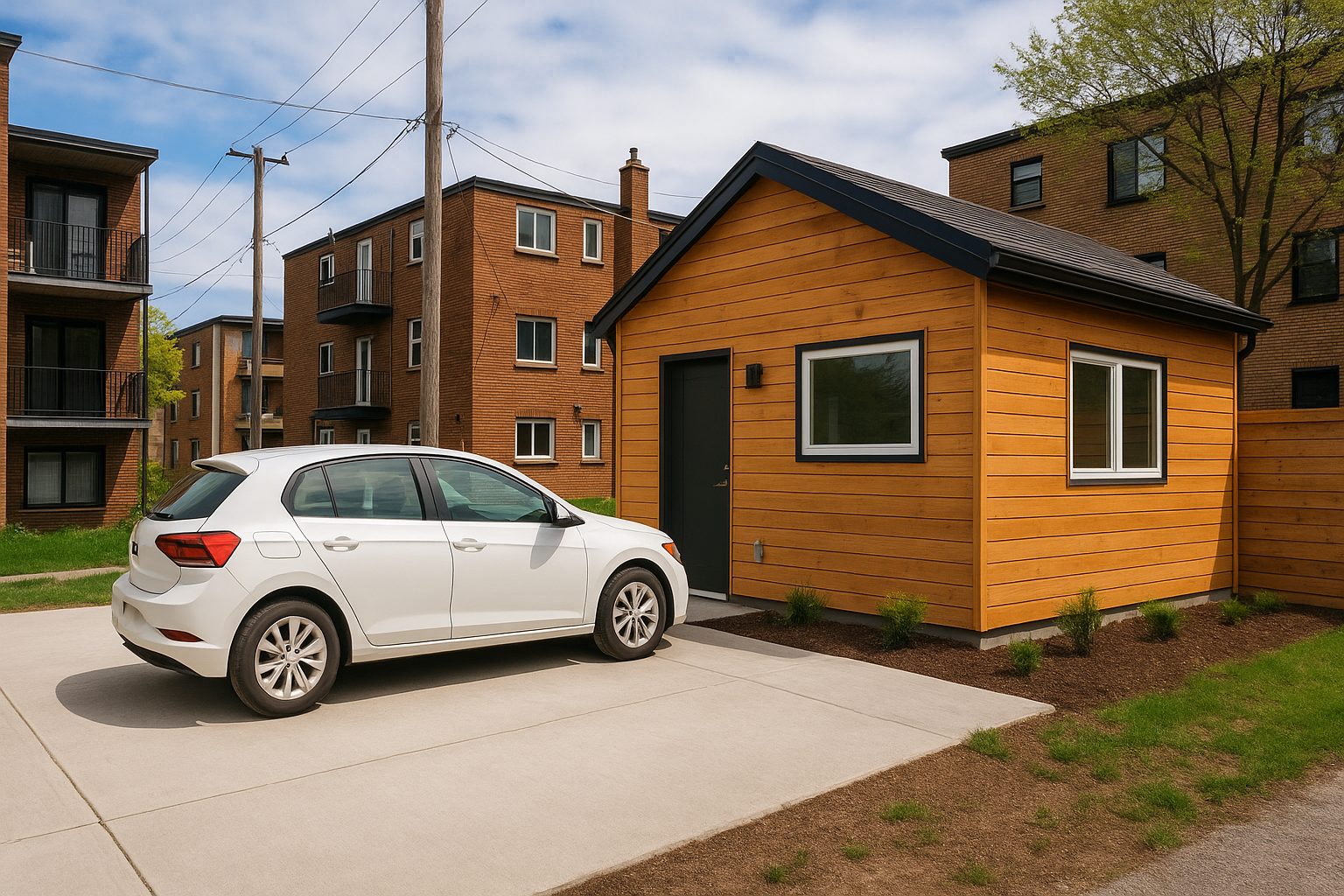
Parking Space ADU: Unlocking New Housing in Canadian Cities with Urban Infill
Estimated reading time: 8 minutes
Key Takeaways
- A parking space ADU transforms unused parking spaces or garages into compact, livable homes to ease urban housing shortages.
- Urban infill strategy: By converting underused spaces, cities can support sustainable development and keep communities vibrant.
- Diverse implementations: Options include enclosed garage conversions, carport renovations, parking pad transformations, and above-garage suites.
Table of contents
Urban Infill and Housing Demand in Canadian Cities
Modern cities across Canada are searching for solutions to provide new housing and make better use of existing urban land. A parking space ADU—an accessory dwelling unit created from a parking space or garage—is an innovative answer to these challenges.
Urban infill means building new homes on land already part of the city—such as empty lots, older parking areas, or underused properties. Instead of expanding through sprawl, Canadian cities are using smart strategies to:
- Create more housing within existing boundaries
- Optimize the use of current infrastructure
- Enhance community vibrancy and sustainability
To support these goals, city planners are easing regulations to integrate ADUs—including garage conversions and parking space ADUs—into neighbourhood designs. For instance, Ontario’s policies encourage municipalities to allow these innovative solutions, as seen in the guidelines provided by Ontario’s notice and the insights from Build Brantford.
What is a Parking Space ADU? Understanding Garage ADU and Parking Conversion
A parking space ADU is a small, efficient home created by converting an existing parking space into living space. This can involve:
- Enclosed garage conversions – where an existing garage is transformed into a studio or one-bedroom apartment.
- Carport conversions – enclosing a carport with windows and insulation for full living amenities.
- Parking pad transformations – turning a paved space into the footprint for a modular home.
- Above-garage suites – constructing a compact home above an existing garage.
Each type offers a quick and flexible way to add new housing without altering the streetscape drastically. For more detailed comparisons, resources like Build Brantford and City of Windsor’s ADU Guide provide extensive insights.
The Process and Benefits of Parking Conversion for New Housing
Step-by-Step Guide to Parking Space ADU Conversion
Converting a parking space or garage involves several deliberate steps to ensure safety, code compliance, and livability:
- Zoning and Permits:
- Design and Building Code Compliance:
- Develop a detailed floor plan including room sizes, window placements, wiring, and insulation.
- Ensure that fire exits, smoke detectors, and HVAC systems meet local building codes.
- Construction:
- Begin with insulation upgrades, followed by installing necessary plumbing and electrical systems.
- Complete the project by adding windows, doors, and finishing elements to create a comfortable living space.
Benefits of Parking Space ADU Conversions
- Economic: Generates rental income and increases property values.
- Environmental: Reduces new construction on greenfields and supports efficient public transit use.
- Community: Promotes diversity, enhances infrastructure utilization, and supports local businesses.
These efficient conversions contribute to sustainable urban growth, as detailed in guides provided by Orillia’s ADU Guide and insights from Bradford West Gwillimbury.
Examples and Inspiration from Canadian Cities with Parking Space ADU and Garage ADU Projects
Across Canada, parking space ADUs and garage conversions are making a tangible impact:
Windsor, Ontario: The city has relaxed zoning rules to enable ADU construction without mandating extra parking. Check out the City of Windsor’s ADU Guide for details.
Brantford, Orillia, and Bradford West Gwillimbury: These cities offer comprehensive guides with sample floor plans, checklists, and photos to assist homeowners in planning their parking conversions. Explore Brantford’s ADU Resource and Orillia’s ADU Guide for inspiration.
Best Practices: Providing clear guidelines, flexible parking rules, and templates has empowered homeowners and streamlined the approval process for parking space conversions.
Practical Tips for Urban Homeowners and Planners Exploring Parking Conversion
For Homeowners
- Check Local Zoning: Read your city’s rules regarding ADUs and parking requirements. Many cities provide these guidelines online.
- Hire an Experienced Designer: Work with architects or contractors who are familiar with ADU design and building code compliance.
- Prepare a Complete Permit Application: Include detailed site plans, architectural drawings, and utility layouts. This will speed up the approval process.
- Plan for Parking Impact: Consider alternatives like bike storage or shared parking if required by local bylaws.
- Use Local Resources: Guides such as Orillia’s Homeowner Guide and Bradford West Gwillimbury’s Guide can prove invaluable.
For Urban Planners
- Update Zoning Bylaws: Modify minimum parking requirements where appropriate to encourage ADU development in transit-friendly areas.
- Develop Practical Guides: Offer sample plans and checklists to aid homeowners in planning their parking conversions.
- Streamline Permitting: Utilize online applications and consider fast-tracking reviews for compliant projects.
- Offer Incentives: Consider grants or rebates for energy-efficient or accessible ADUs to encourage sustainable development.
These strategies, supported by research and city case studies, highlight the benefits of using parking space conversions as a practical urban infill solution. More details can be found through resources like Ontario Urban Infill Policy and insights from City of Windsor.
Conclusion: A Forward-thinking Path to New Housing in Canadian Cities
Transforming underutilized parking spaces and garages into modern homes represents a vital solution to the housing shortages facing Canadian cities. Parking space ADUs not only add much-needed housing but also support urban infill, reduce sprawl, and make better use of existing infrastructure.
Whether you’re a homeowner seeking additional rental income or a planner looking to invigorate neighbourhoods, now is the time to recognize the potential of every parking spot. Embrace the change and explore resources like the Ontario Urban Infill and ADU Policy, Brantford’s ADU Information, and the City of Windsor’s Additional Dwelling Units for further guidance.
Let’s unlock the hidden potential of our cities—one parking space ADU at a time.
Frequently Asked Questions
Q1: What qualifies as a parking space ADU?
A: A parking space ADU is a compact living unit created by converting a parking space, garage, or similar structure into a habitable space. The conversion includes insulation, windows, and adherence to local building codes.
Q2: Are parking space ADUs legal in all Canadian cities?
A: Regulations vary by municipality. Many cities are adapting their zoning rules to allow such conversions, but it’s important to review local bylaws and secure the necessary permits.
Q3: How do parking space ADUs contribute to urban infill?
A: By converting underused parking areas into livable housing, these ADUs support denser, more sustainable urban development without the need for widespread new construction.

Leave a Reply